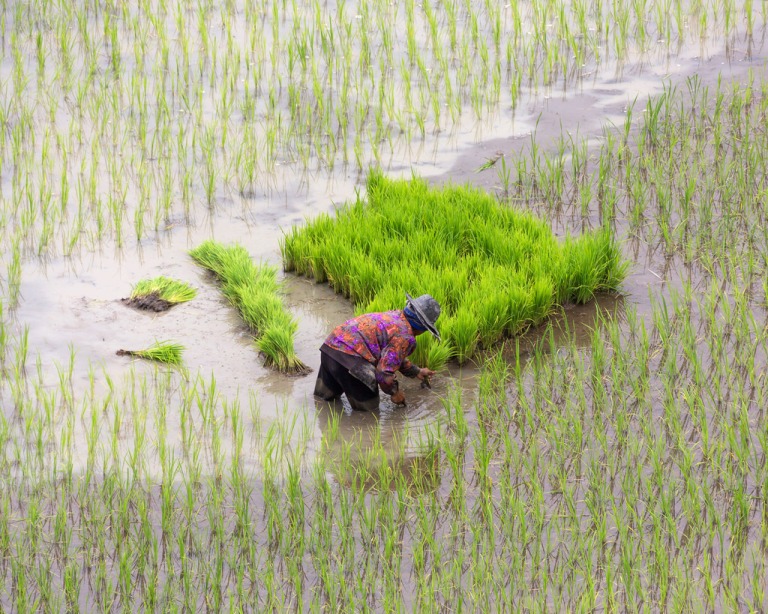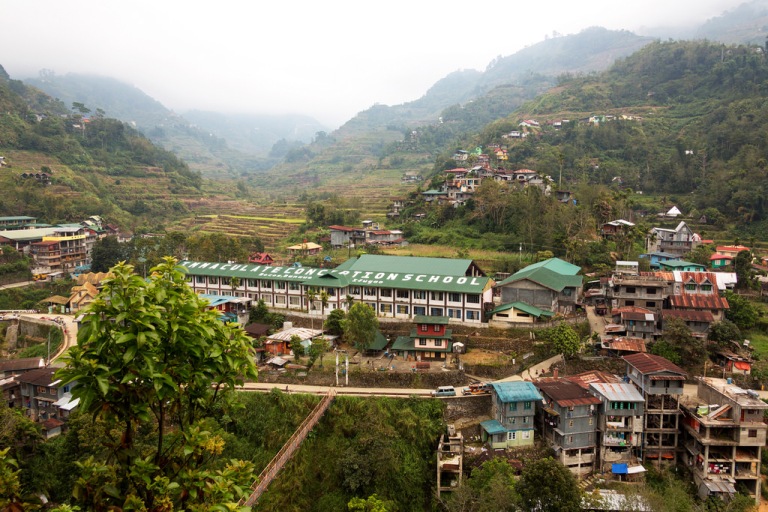The night bus from Manila to Banaue should have taken about eight hours, but – thanks to construction and bumper-to-bumper traffic, even in the middle of the night – we were on the road for more than 12 hours. My stomach held steady, and I even managed to occasionally nod off into some kind of consciousness purgatory, not quite asleep but not quite awake.
Banaue (pronounced buh-NAH-wee) is a mid-sized town in the middle of northern Luzon’s Cordilleras, a craggy, jungle-covered mountain range cut by steep valleys and lined with rice terraces that have been painstakingly sculpted from the hillsides over the course of two thousand years.
At Banaue I was met by Regina, a local guide who worked for the hotel I’d booked for the next two nights. She talked me into a three-hour hike, and soon after lunch we rode a tricycle (the Filipino version of a rickshaw or tuk-tuk, basically a motorcycle attached to a partially enclosed sidecar) up to the main viewpoint overlooking Banaue’s Ifugao rice terraces.

From the viewpoint we cut over to the other side of the valley and worked our way back down towards the central town. Usually we walked along the edges of the terraces, with a rice paddy to our left and a steep drop to our right. Not long into our hike I slipped clumsily on a thin area of moss-covered rocks and wiped out. My left foot plunged into the rice field’s deep mud, and my camera, still in my hand, knocked against the rocks so hard I thought I might have broken it. I hadn’t expected my first spill of the trip to come so quickly! My camera was fine, but I’m not sure my left hiking shoe will ever again smell anything other than funky. Regina, more upset than I was, seemed to be reconsidering the wisdom of taking me on a path that required a basic level of coordination.
The rest of our hike was incident-free. It was fun to walk by the homes of the local farmers and see them at work in the fields. Regina said over 800 people work in the Banaue terraces, and that they eat, not sell, everything they harvest.


The next morning I walked back up to the main viewpoint, stopping for lots of photos and somehow managing to sink my left shoe into the mud again.





My next stop was Batad, a nearby village perched on a hillside that overlooks an especially impressive rice terrace. The logistics of getting to Batad remained slightly mysterious. I knew it wasn’t on the road system and required some walking, but neither my guidebook nor the locals provided much detail. I’d hired a tricycle to take me as close as possible and waited at my hotel for the driver to pick me up.
“Too much,” said a hotel clerk, pointing at my two bags. This particular guy had been consistently cranky and unhelpful, and I wasn’t sure what to make of his comment.
“Too much to carry to Batad?” I asked.
“Yes, too much. You leave one bag here.”
My driver had just arrived, but it sounded like I needed to make an adjustment. As quickly as possible I shifted essential stuff to my backpack and everything else to my rolling duffel. I was only staying in Batad one night and didn’t need much.
From Banaue we drove about 45 minutes to “the Saddle,” a pass over the mountains above Batad. The paved road continued downhill from there another mile or so, and my driver took me to the point where the road ended and a jungle trail began. He said I’d have to walk all the way back to the Saddle the next day to meet him, though, because the road was too steep for his tricycle to carry two people uphill.

The hotel clerk I’d initially disliked had done me a huge favor. The jungle trail to Batad was short, but carrying both my bags down to the village and then back up to the Saddle would have been a real chore.

The first view of the Batad rice terraces hits you all at once when you arrive at the village. The entire slope of the mountain has been crafted into something that looks more like art than agriculture.

All the hotels in Batad are extremely basic – primitive shared bathrooms, no wifi, no power outlets in the rooms. But the setting is tough to beat. My hotel directly overlooked the terraces, and the view from my tiny $6 a night room was incredible. A local told me that about 80 tourists visit Batad each day, many of them Filipinos from Manila, and most don’t stay overnight.



The next morning I stood at my window watching the sun rise and listening to the sounds of the village waking up. The roosters weighed in first and loudest, then flip-flops began slapping on dirt paths, dogs barked, fires crackled to life, kids yelled to each other across long distances, machetes hacked at the encroaching vegetation, and old women – some literally bent 90 degrees at the waist by a lifetime of heavy work – swept floors. The sounds of car engines and honking horns were conspicuous by their absence. Batad didn’t even seem to have a generator, or any draft animals. I hadn’t seen a single horse, cow, or buffalo. All the work was done by hand.
After a quick breakfast I hiked down past Babloi, the small village in the middle of the rice fields. The paths between the terrace levels were often nearly vertical, and when I went up or down I unashamedly used my hands to steady myself. The paths along the edges of the terraces were mostly wide and level, but I was gun shy after my previous spills and didn’t have any trouble picturing embarrassing scenarios. If I fell in one direction I’d land in a rice paddy and sink in the mud. If I fell in the other direction I’d plummet about 10 feet before landing in a rice paddy and sinking in the mud.







Around noon I began the hike back up to the Saddle, stopping for a few final photos of the amazing views. Some local kids reminded me of the culture-crossing power of a simple smile, how it can entirely transform the attitude of someone you encounter. Too often I forget that.




Back in Banaue the hotel I’d stayed at was kind enough to let me shower before catching the night bus back to Manila.

Those are lovely photos you you’ve got!
LikeLike
Thanks Onil!
LikeLiked by 1 person